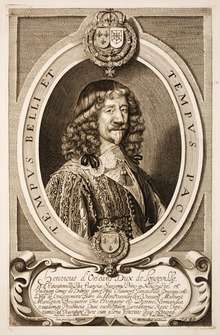Henri II d'Orléans, Duke of Longueville

Henri II d'Orléans, duc de Longueville or Henri de Valois-Longueville (6 April 1595 – 11 May 1663), a legitimated prince of France (of royal descent) and peer of France, was a major figure in the civil war of France, the Fronde,[1] and served as governor of Picardy, then of Normandy.
He was the only son of Henri I d'Orléans, duc de Longueville and Catherine Gonzaga.
Longueville headed the French delegation in the talks that led to the Treaty of Westphalia which ended the Thirty Years War (1648). In his role as sovereign prince of Neuchâtel, and acting as antagonist of the Habsburg power rather than as liberal benefactor, he succeeded in obtaining formal exemption from the Holy Roman Empire for all cantons and associates of the Swiss Confederacy.
In 1642 he married Anne Geneviève de Bourbon; his brother-in-law was Louis II de Bourbon, Prince de Condé, leader of the aristocratic party in the Fronde. After the Peace of Rueil (11 March 1649) had ended the first phase of the civil war, Mazarin's sudden arrest of the Grand Condé, his brother the prince de Conti and their brother-in-law the duc de Longueville, on 14 January 1650 precipitated the next phase of the Fronde, the Fronde des nobles.
He appointed Dominique Bouhours as tutor to his two sons.
Family
He married his first wife Louise de Bourbon in Paris on 10 April 1617, their children were:
- Marie (1625–1707), who married Henri II, Duke of Nemours;
- Louise (1626-1628);
- X (1634-1634).
After his first wife's death he married Anne Geneviève de Bourbon in 1642, their children were:
- Charlotte Louise, Mademoiselle de Dunois (1645-1664);
- Jean Louis Charles d'Orléans, Duke of Longueville (1646-1694);
- Marie Gabrielle (1646-1650);
- Charles Paris d'Orléans, Duke of Longueville (1649-1672).
Notes
- ↑ He was also duc d'Estouteville and of Coulommiers, sovereign prince of Neuchâtel and Valangin, prince de Châtellaillon, comte de Dunois.
External list
| Henri II d'Orléans, Duke of Longueville Cadet branch of the House of Valois Born: 6 April 1595 Died: 11 May 1663 | ||
| French nobility | ||
|---|---|---|
| Preceded by Henri I |
Duke of Longueville 8 April 1595 – 11 May 1663 |
Succeeded by Jean Louis Charles |
| Regnal titles | ||
| Preceded by Henri I |
Prince of Neuchâtel 8 April 1595 – 11 May 1663 |
Succeeded by Jean Louis Charles |